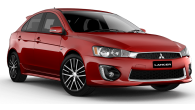There's always a risk when revisiting the past that you won't be able to recreate what you once adored. That was the way it was when Jaguar launched the S-Type in 1999 with much ado about the great Mark II that helped forge Jaguar's great sporting tradition in the 1960s.
The S-Type had a much tougher task to shine against great cars from Europe and Japan. It wasn't possible for the S-Type to stand out like its legendary predecessor, and yet by recalling the Mark II, Jaguar created an expectation that it would.
MODEL WATCH
The S-Type was a classic Jaguar from tip to toe with an athletic profile that flowed smoothly from its retro grille to its truncated rump. The headlamps and adjacent driving lamps screamed "Mark II", the only thing missing being the famous leaper bonnet mascot. If there was a criticism it was that the large panels and the relatively small glass area combined to make it look heavy when compared with the likes of its BMW and Benz rivals. Inside it felt a little claustrophobic and sombre. The dash, with an appropriate finish of woodgrain, was tall and bluff, which made the Jaguar's cockpit feel confined.
Leather was used on the seats, which were supportive and comfortable, and there were all the appropriate features like air-conditioning, CD sound and cruise, along with a full array of instruments.
It looked the part, but the real test for the S-Type was in the driving experience. Power was provided by a choice of V6 or V8 plants. The V6 was a double overhead camshaft 3.0-litre unit pumping out 179kW at 6800 revs and 300Nm at 4100 revs.
The V8 was a smooth and zesty four-litre double overhead cam unit with 209kW at 6100 revs and 380Nm at 4100 revs. Jaguar offered a choice of transmissions. There was a five-speed auto available with both the V6 and V8 and a five-speed manual gearbox, but that was only offered on the Sport models. As with all great sporting cars, the drive was directed to the rear wheels.
Suspension was independent front and rear, and the handling was nicely balanced when pressed on a challenging road. It's times like that you also appreciate the presence of four-wheel disc brakes should your exuberance outstrip your ability.
Of course the addition of ABS added to the S-Type's dynamic safety. The S-Type was packed with plenty of features including alarm, immobiliser, adjustable steering column, power windows and mirrors and a trip computer.
IN THE SHOP
Early cars had troubles with the power steering hoses blowing. V8s were more prone to the problem than the V6. Jaguars tend to be bought by enthusiasts who are prepared to look after them and have them serviced according to factory recommendations. Check carefully for signs of crash damage, such as ill-fitting panels, variable door gaps or mismatching paint.
OWNER'S VIEW
Anne Tootell owns a 1999 3.0-litre V6 and loves the ease of driving, the dual climate control airconditioning and exceptional economy when touring on the open road (less than 10L/100 km). Her only criticism is that the British Racing Green paintwork demands constant attention.
Jaguar S-Type 99-02
* Ford fittings are a let down
* Confined interior a little claustrophobic
* Powerful V6 and smooth V8 engines
* Clumsy manual shift using J-gate
* Retro styling evokes memories of past greats
Rating
14/20 Smooth classy prestige sedan a little too stuck in the past.
Jaguar S Type 1999: V6
| Engine Type | V6, 3.0L |
|---|---|
| Fuel Type | Premium Unleaded Petrol |
| Fuel Efficiency | 12.5L/100km (combined) |
| Seating | 5 |
| Price From | $5,500 - $7,700 |


.jpg)

.jpg)













.png)


.jpg)

